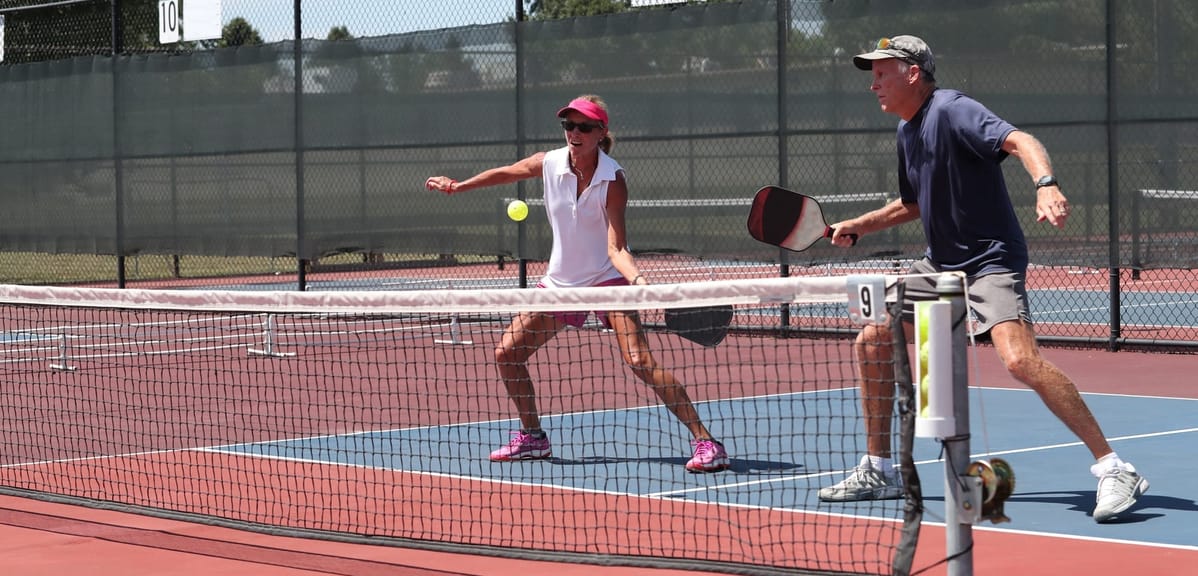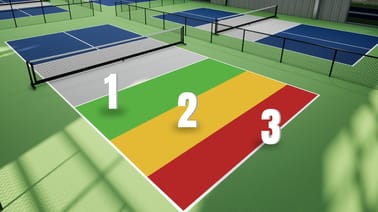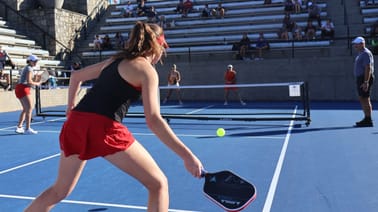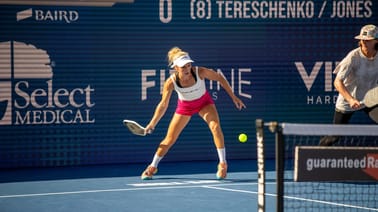
Winning Strategies and Benefits for Lefty-Righty Doubles Partners
As we discussed in our previous article on the key differences between playing the left side and right side in doubles pickleball, a lefty-righty partnership is considered the future of pickleball (Ben’s words, not mine).
The big advantage comes in having two forehands in the middle, where most balls are hit.
Now we'll examine what makes a lefty-righty partnership so special and provide some strategies for taking advantage of it.
Playing with a lefty
Left-handed people only make up about 10 percent of the world's population, so it's pretty rare to play pickleball against a southpaw. In fact, if you’re like me, you don’t even realize your opponent is left-handed until what you thought was a speedup winner comes screaming back at you.
1000 mg sodium, 200 mg potassium, 60 mg magnesium.
That's LMNT's science-backed electrolyte ratio. I said I watch a lot of pickleball, well I also play a lot...and for over two years, I've been using LMNT. When you sweat, the primary electrolyte lost is sodium.
You can lose up to 7 grams per day. When sodium isn’t replaced, it’s common to experience muscle cramps and fatigue, aka game-killers.

I have at least one-a-day (I'm a raspberry guy), even when I don't play, so it's pretty easy for me to recommend LMNT to The Dink Fam.
It's nice to endorse products that I actually use...
-- Thomas Shields, Founder, The Dink
It turns out that having two forehands in the middle of the court can be quite an advantage, but only if used properly.
All this is not to say that playing with a lefty teammate is easy. This video from CJ Klinger and Simone Jardim discusses some of the worries right-handers have playing with a lefty. Ironically, the big concern is whose responsibility it is to cover the middle balls.
The battle for the middle
We've all clapped paddles with our playing partner before, and typically, it’s not a good shot. When two righties are on the same team, fixing this issue simply means saying, "It’s my forehand," and leaving it at that.
For a lefty-righty team, though, who has the right of way?
There are a few ways you can decide:
- You can always give the middle ball to the left-side player
- The player with the stronger forehand takes it
- Whoever calls it gets it
Regardless of which you choose, the earlier you can decide, the better. If it takes a few points to realize that your partner is using the "wrong" hand, simply call a quick timeout and decide. If you don’t have hand-blindness like most of us, have a quick discussion at the start of the game.
You’ll likely figure it out on your own when you have a consistent lefty-righty partnership. It took me and my left-handed doubles partner about 10 matches before we fell into a good pattern. I’m pretty sure we went 0-10 during that stretch. But now that we figured it out, we’re almost unbeatable.
Stacking is a must
When I first started stacking, I hated it. I was completely in my head and found it difficult to remember where I was supposed to be for each point. After a handful of matches, it became more comfortable.
If you need a lesson in stacking, check out this great video by ThatPickleballGuy.
The key to getting good at it is just to keep doing it. Even if it’s awful initially, trust me, you’ll get there eventually.
Don't be afraid to overcommunicate
Of course, this advice works for any partnership, but it might be even more important in a lefty-righty combo. A simple "mine" or "yours" goes a long way toward having a better and less frustrating match.
Strategies for lefty-righty teams
Let's discuss strategy now that you know what makes lefty-righty teams unique.
Funnel Your Attacks
We've discussed how the advantage of a lefty-righty combo comes mostly from having two forehands in the middle. But we haven't discussed that the middle is relative to wherever you are positioned. On the surface, you’d think the middle is the centerline, but that's not completely true.
The middle actually moves as you move. Understanding this concept allows you to take advantage no matter where you are.
This diagram can help you visualize it:
Notice how, as you and your partner move forward, you create a funnel toward one opponent (and hopefully their backhand). This funnel allows you to take the center with you and actually shrink the court for your opponent. Yes, you’re giving up more room toward the far side of the court, but it’s a more difficult shot for your opponent to make.
If they aren’t patient or attempt an attack between the two of you, then they’re in big trouble.
To create this funnel:
- Drop your third (and/or fifth) to one of your opponent’s backhands.
- Both players slide over toward that same opponent as they move up to the kitchen – with the far-side player covering the T (where the NVZ line and centerline meet).
The opponent has a few choices, and none of them are great:
- They can try to go crosscourt, but if it’s not a perfect shot, it’s either going out of bounds or being hit for a putaway.
- They can go up the line, risking an Erne attempt.
- They can go middle, where two dangerous forehands are waiting.
- Or they can reset in the middle, conceding the kitchen and their advantage.
If executed well, this guarantees that you and your partner are in the driver’s seat of the point. You are daring them to try something, ready to pounce if they do.
Sign up today for the most informative newsletter in pickleball from The Dink!
Why it works
Funneling the ball toward one opponent creates a two-on-one matchup. You’re essentially taking their partner out of the point, at least for a few shots. Even if they are able to reset the middle on you, you can dink the ball back to their outside or inside foot in hopes of continuing your superior positioning. If they work their way out of it, you’ve lost nothing, because you and your partner are at the kitchen line.
Funneling works for same-handed partners as well, but there’s something so much more intimidating about the two forehands in the middle that it seems to work even better with opposite hands.
Find and maximize your strengths
In analyzing some of my own matches recently, I discovered some interesting stats for me and my left-handed partner (shout out to Kyle). When I hit the third shot (whether it’s a drop or a drive), we win the point 56 percent of the time. When Kyle hits a third (drop or drive), we win the point 48 percent of the time. It's not a massive drop-off, but it could be the difference between winning by two points or losing by two points.
The question is, why does it matter? Perhaps it’s because I’m better at third shots, but that’s not true. Instead, I think it’s because my partner is better at being the aggressor at midcourt and the kitchen. By me taking the third, he can be free to roam and look for putaways or move the ball into a corner where we can work on our funnel.
Now that we know this, we can alter our strategy so that if a ball is hit middle while at the baseline, then I take it with my forehand. But if it’s hit into the middle while we’re closer to the net, he takes it with his forehand.
By understanding our strengths, we can form a strategy that fits us instead of following generic advice like "left side takes the forehand." This makes us more dangerous against our opponents and more chances to control the rally.









